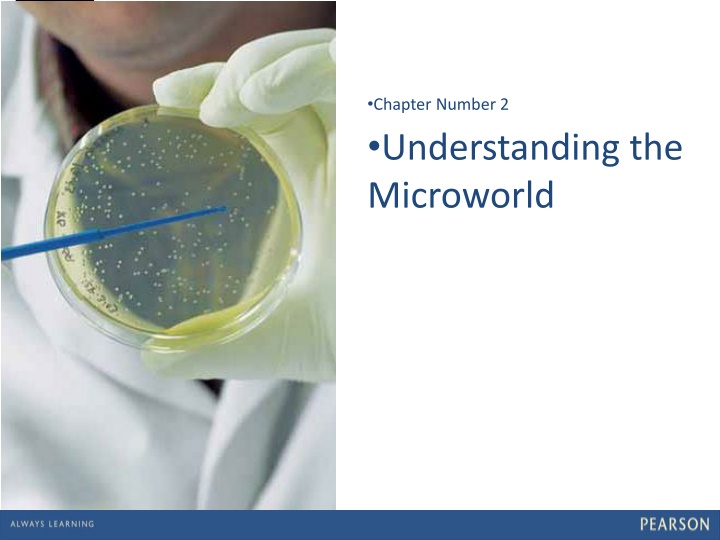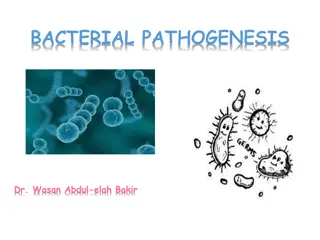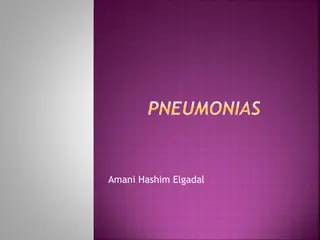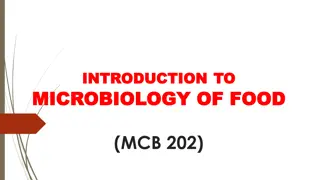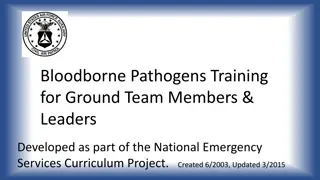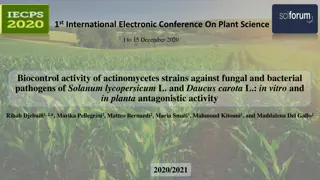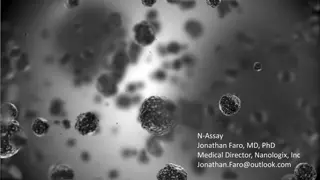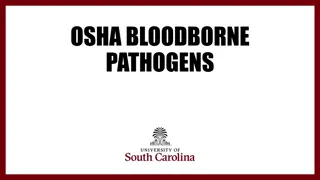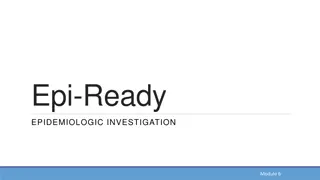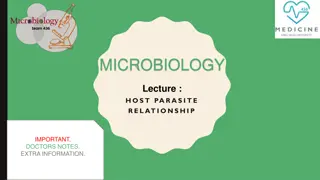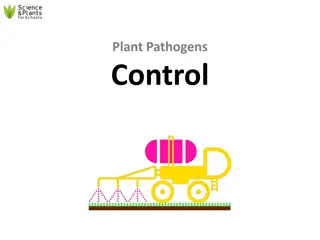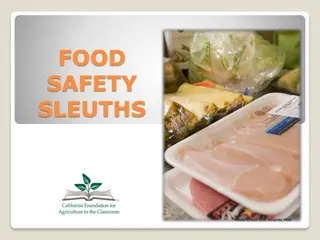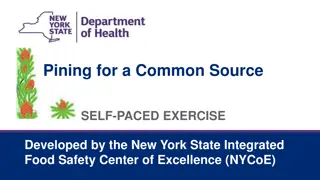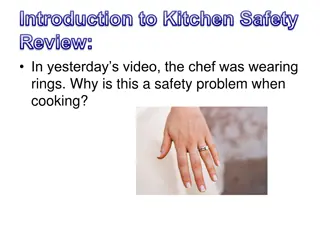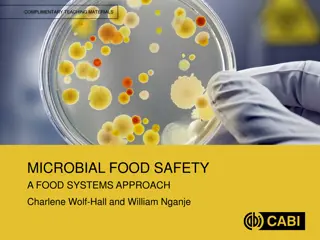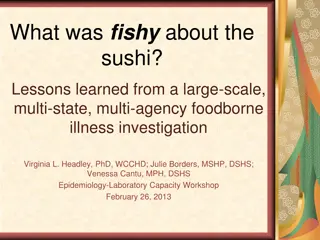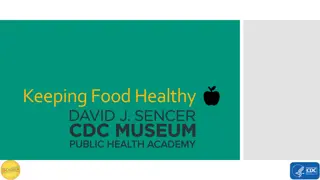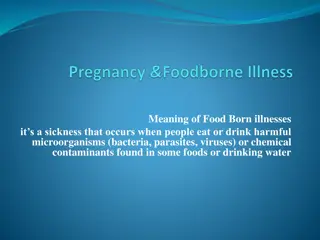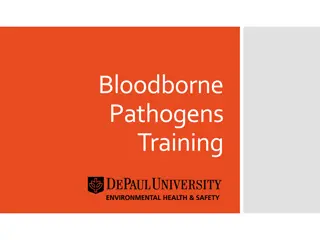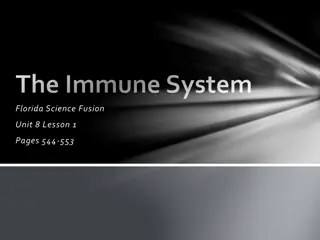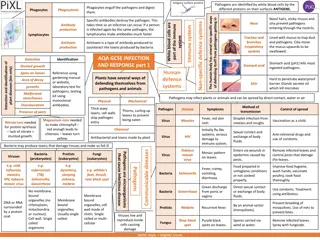The Microworld: Factors Affecting Foodborne Pathogens
This chapter delves into the microworld of microorganisms and pathogens that can contaminate food, leading to foodborne illnesses. It covers key terms such as bacteria, viruses, parasites, and fungi, along with topics on preventing contamination, understanding spores, and the temperature danger zone for microbial growth.
Download Presentation

Please find below an Image/Link to download the presentation.
The content on the website is provided AS IS for your information and personal use only. It may not be sold, licensed, or shared on other websites without obtaining consent from the author.If you encounter any issues during the download, it is possible that the publisher has removed the file from their server.
You are allowed to download the files provided on this website for personal or commercial use, subject to the condition that they are used lawfully. All files are the property of their respective owners.
The content on the website is provided AS IS for your information and personal use only. It may not be sold, licensed, or shared on other websites without obtaining consent from the author.
E N D
Presentation Transcript
Chapter Number 2 Understanding the Microworld 1
Learning Objectives After this presentation, you should be able to complete the following Learning Outcomes 2.0 Factors that affect the growth of foodborne pathogens (FAT TOM) 2.1 2.2 Characteristics of TCS food Major foodborne pathogens and their sources 2.3 Ways of preventing viral, bacteria, parasitic, and fungal contamination 2.4 2.5 Naturally occurring toxins and how to prevent their illnesses 2
2.0 KEY TERMS Microorganisms: Small, livingorganisms that can be seen onlywith the aid of a microscope. Thereare four types of microorganismsthat can contaminate food andcause foodborne illness: bacteria, viruses, parasites, and fungi. Pathogens: Illness-causing microorganisms. Toxins: Poisons produced bypathogens, plants, or animals. Someoccur in animals as a result of theirdiet.
2.0 KEY TERMS Bacteria: Single-celled, livingmicroorganisms that can spoilfood and cause foodborne illness.Bacteria present in food can quickly multiply to dangerous levels whenfood is incorrectly cooked, held, orreheated. Some form spores thatcan survive freezing and very hightemperatures. FAT TOM: Acronym for theconditions needed by mostfoodborne microorganisms to grow: food, acidity, temperature, time,oxygen, moisture.
2.0 KEY TERMS Temperature danger zone: The temperature range between 41 and 135 F (5 to 57 C),within which most foodborne microorganisms rapidly grow. Water activity (a): Amount ofmoisture available in food formicroorganisms to grow. It ismeasured in a scale from 0.0 to 1.0,with water having a water activity(aw) of 1.0. TCS food typically hasa water- activity value of 0.85 orhigher.
2.0 KEY TERMS Spore: Form that some bacteria can take to protect themselves when nutrients are not available. Spores are commonly found in dirt and can contaminate food grown there. A spore can resist heat, allowing it to survive cooking temperatures. Spores can also revert back to a form capable of growth. This can occur when food is not held at the correct temperature or cooled or reheated correctly. Virus: Smallest of the microbial food contaminants. Viruses rely ona living host to reproduce. They usually contaminate food througha food handler s incorrect personal hygiene. Some survive freezing andcooking temperatures.
2.0 KEY TERMS Spore: Form that some bacteria can take to protect themselves when nutrients are not available. Spores are commonly found in dirt and can contaminate food grown there. A spore can resist heat, allowing it to survive cooking temperatures. Spores can also revert back to a form capable of growth. This can occur when food is not held at the correct temperature or cooled or reheated correctly. Virus: Smallest of the microbial food contaminants. Viruses rely ona living host to reproduce. They usually contaminate food through a food handler s incorrect personal hygiene. Some survive freezing and cooking temperatures.
2.0 KEY TERMS Parasite: Organism that needs to live in a host organism to survive. Parasites can be found in water and inside many animals, such as cows, chickens, pigs, and fish. Correct cooking and freezing will kill parasites. Avoiding cross-contamination and practicing correct handwashing can also prevent illness. Fungi: Ranging in size from microscopic, single-celled organisms to very large, multicellular organisms, fungi most often cause food to spoil. Molds, yeasts, and mushrooms are examples. Mold: Type of fungi that causes food spoilage. Some molds produce toxins that can cause foodborne illness. Yeast: Type of fungi that causes food spoilage.
Factors That Affect the Growth of Foodborne Pathogens 2.1 FOOD ACIDITY FAT T TIME TEMPERATURE OXYGEN MOISTURE 9
Factors That Affect the Growth of Foodborne Pathogens 2.1 FOOD Most bacteria need nutrients such as carbohydrates or proteins to survive. This includes meat, poultry, dairy products, and eggs. 10
Factors That Affect the Growth of Foodborne Pathogens 2.1 ACIDITY Bacteria grow best in food that is neutral to slightly acidic, a pH of 7.5 to 4.6. The following common types of food have a pH that is ideal for bacterial growth: Bread pH 5.0 6.0 Raw Chicken pH 5.5 6.0 Canteloupe pH 6.1 6.5 Milk pH 6.4 6.8 11
Factors That Affect the Growth of Foodborne Pathogens 2.1 TEMPERATURE Bacteria grow rapidly between 41 and 135 F (5 and 57 C) This is called the Temperature Danger Zone. Bacteria grow even more rapidly from 70 to 125 F (21 to 52 C). 12
Factors That Affect the Growth of Foodborne Pathogens 2.1 TIME Bacteria need time to grow. The more time bacteria spend in the temperature danger zone, the more opportunity they have to grow to unsafe levels. Foodborne Illness 13
Factors That Affect the Growth of Foodborne Pathogens 2.1 OXYGEN Some bacteria need oxygen to grow. Others grow when oxygen is not there. Bacteria that grow without oxygen can occur in: Baked Potatoes Garlic/Oil Mixes Cooked Rice 14
Factors That Affect the Growth of Foodborne Pathogens 2.1 MOISTURE Bacteria grow well in food with high levels of moisture. The amount of moisture available in food for this growth is called water activity (aw). The aw scale ranges from 0.0 to 1.0. The higher the value, the more available moisture in the food. 15
2.2 Characteristics of TCS Food TCS (Time and Temperature Control for Safety): TCS food is typically moist and contains protein, as well as having a neutral or slightly acidic pH. 16
2.2 Characteristics of TCS Food TCS (Time and Temperature Control for Safety): This food also has a history of involvement in foodborne illness outbreaks, as well as a natural potential for contamination due to methods used to produce/process it. 17
2.3 Major Foodborne Pathogens Microorganisms are small, living organisms that can be seen only through a microscope. Many microorganisms are harmless, but some can cause illness. These are called pathogens. Some pathogens make you sick when you eat them. Others produce poisons or toxins that make you sick. 18
2.3 Major Foodborne Pathogens Ways Pathogens can be Spread Person to person Touching dirty food-contact surfaces and then touching food Sneezing or vomiting onto food or food-contact surfaces 19
2.3 Major Foodborne Pathogens The symptoms of a foodborne illness vary, depending on which illness a person has. But most victims share some common symptoms: Diarrhea Vomiting Fever Nausea Abdominal cramps Jaundice (a yellowing of the skin and eyes) 20
2.3 Major Foodborne Pathogens The Big Five Shigella spp Salmonella Typhi Enterohemorrhagic and shiga toxin-producing E. coli Hepatitis A Norovirus 21
Ways of preventing viral, bacterial, parasitic, and fungal contamination 2.4 Prohibit food handlers who are vomiting or who have diarrhea or jaundice from working Prevent Contamination Make sure food handlers wash their hands regularly and correctly Avoid bare- hand contact with ready-to-eat food 22
Naturally occurring toxins and ways of preventing illnesses from them 2.5 Seafood Toxins Fish toxins can be a natural part of the fish. Other toxins are made by pathogens on the fish. Some also occur when fish eat smaller fish containing the toxin. Shellfish, such as oysters, can likewise become contaminated when they eat marine algae that have a toxin. 23
Naturally occurring toxins and ways of preventing illnesses from them 2.5 MUSHROOM TOXINS Foodborne illnesses linked with mushrooms are almost always caused by eating toxic wild mushrooms collected by amateur hunters. Purchasing products from approved, reputable suppliers helps prevent these types of foodborne illnesses. 24
Naturally occurring toxins and ways of preventing illnesses from them 2.5 PLANT TOXINS Plant toxins are another form of biological contamination. Illnesses from plant toxins usually happen because an operation has purchased plants from an unapproved source. The following are examples of items that have made people sick: Toxic plants, such as fool s parsley or wild turnips, mistaken for the edible version Honey from bees allowed to harvest nectar from toxic plants Undercooked kidney beans 25
